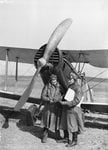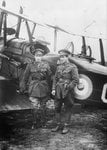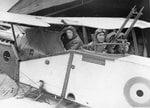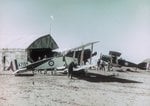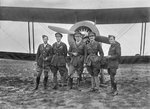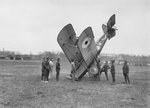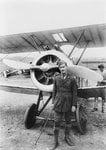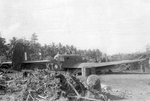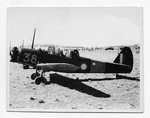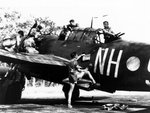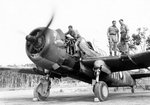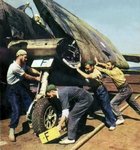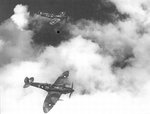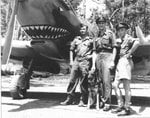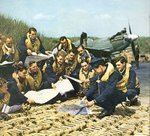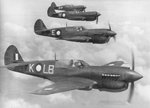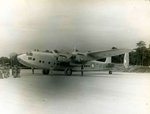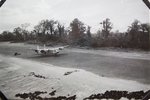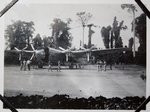Royal Australian Air Force
The RAAF is one of the oldest air forces of the world. In March 1914 the Australian Flying Corps was established. The first unit however was not formed until August 1914. During that month the Central Flying School saw the light of day at Point Cook and up until 1994 this was the principle aviation school of the RAAF. Many squadrons saw action in Europe during the First World War. Four squadrons were used to fight the Germans in Egypt (1sq and 2sq) and France (2sq after it's Egypt adventure, 3sq and 4sq). In 1919 all four units were disbanded again. On March 31st, 1921 the Australian Air Force was established as independent part of the Australian defence. In June of the same year King George V awarded the title "Royal" to this organisation and since than it is known as the Royal Australian Air Force. During these early days the (R)AAF had more aircraft on strength than personnel! The 151 officers and troops were able to utilize 157 aircraft. Reason for this was the large surplus of aircraft after the First World War. In 1923 the RAAF expanded further and started flight operations at RAAF Laverton and RAAF Richmond.
The crisis during the 1930s resulted in slow growth of the RAAF. Little money was available to replace the mostly obsolete aircraft. When Japan attacked Pearl Harbour the RAAF consisted out of 21 squadrons operating a total of 246 aircraft. Of these only 164 could be called operational fighters or bombers and again, most of them were obsolete. As with the Americans and British fighting forces, the RAAF expanded enormously during the initial years of the Second World War. In 1945 the Air Force was at its largest with a staggering 5,000 aircraft in service. Even though the RAAF decreased in size after 1945, there was little room for rest. The men and women from Down Under were deployed during the Berlin crisis (1948-1949), Malaya civil wars (1950-1958), Korean war (1950-1953), Thai communist clashes (early '60s), Vietnam (1964-1972), the Gulf war (1990-1991) and more recently during Operation Iraqi Freedom (2002). During the last operation, 14 F/A-18A Hornets of 75 sq were deployed under coded-name Operation Falconer to Al Udeid, Qatar. Support was given by three C-130H/J's of 36/37 sqn and the B707 tanker aircraft. Two AP-3C Orions were also deployed. The AAAVN was involved with a couple of CH-47D Chinooks based at Azraq in Jordan while the RAN had a Sea King Mk50 helicopter at the LPA-51 HMAS Kanimbla.
Over the last couple of years the order of battle is quite stable. The only major change took place end 1989/early 1990 when all helicopters were transferred to the Australian Army Aviation Corps. To be able to defend Australia against foreign attacks the RAAF opened several so called bare bases. During the '90s the last one was opened along the northern coast. These bases consist out of a runway, taxi-ways and a limited number of shelters and buildings. Usually no aircraft can be found here except during exercises. On a regular basis the RAAF front line squadrons deploy to the bare bases for weapons training and war games.
The RAAF is one of the oldest air forces of the world. In March 1914 the Australian Flying Corps was established. The first unit however was not formed until August 1914. During that month the Central Flying School saw the light of day at Point Cook and up until 1994 this was the principle aviation school of the RAAF. Many squadrons saw action in Europe during the First World War. Four squadrons were used to fight the Germans in Egypt (1sq and 2sq) and France (2sq after it's Egypt adventure, 3sq and 4sq). In 1919 all four units were disbanded again. On March 31st, 1921 the Australian Air Force was established as independent part of the Australian defence. In June of the same year King George V awarded the title "Royal" to this organisation and since than it is known as the Royal Australian Air Force. During these early days the (R)AAF had more aircraft on strength than personnel! The 151 officers and troops were able to utilize 157 aircraft. Reason for this was the large surplus of aircraft after the First World War. In 1923 the RAAF expanded further and started flight operations at RAAF Laverton and RAAF Richmond.
The crisis during the 1930s resulted in slow growth of the RAAF. Little money was available to replace the mostly obsolete aircraft. When Japan attacked Pearl Harbour the RAAF consisted out of 21 squadrons operating a total of 246 aircraft. Of these only 164 could be called operational fighters or bombers and again, most of them were obsolete. As with the Americans and British fighting forces, the RAAF expanded enormously during the initial years of the Second World War. In 1945 the Air Force was at its largest with a staggering 5,000 aircraft in service. Even though the RAAF decreased in size after 1945, there was little room for rest. The men and women from Down Under were deployed during the Berlin crisis (1948-1949), Malaya civil wars (1950-1958), Korean war (1950-1953), Thai communist clashes (early '60s), Vietnam (1964-1972), the Gulf war (1990-1991) and more recently during Operation Iraqi Freedom (2002). During the last operation, 14 F/A-18A Hornets of 75 sq were deployed under coded-name Operation Falconer to Al Udeid, Qatar. Support was given by three C-130H/J's of 36/37 sqn and the B707 tanker aircraft. Two AP-3C Orions were also deployed. The AAAVN was involved with a couple of CH-47D Chinooks based at Azraq in Jordan while the RAN had a Sea King Mk50 helicopter at the LPA-51 HMAS Kanimbla.
Over the last couple of years the order of battle is quite stable. The only major change took place end 1989/early 1990 when all helicopters were transferred to the Australian Army Aviation Corps. To be able to defend Australia against foreign attacks the RAAF opened several so called bare bases. During the '90s the last one was opened along the northern coast. These bases consist out of a runway, taxi-ways and a limited number of shelters and buildings. Usually no aircraft can be found here except during exercises. On a regular basis the RAAF front line squadrons deploy to the bare bases for weapons training and war games.

